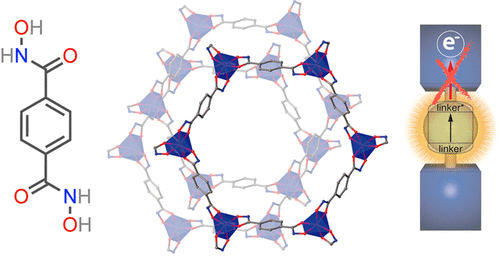当前位置:
X-MOL 学术
›
J. Am. Chem. Soc.
›
论文详情
Our official English website, www.x-mol.net, welcomes your
feedback! (Note: you will need to create a separate account there.)
Hydroxamate titanium-organic frameworks and the effect of siderophore-type linkers over their photocatalytic activity
Journal of the American Chemical Society ( IF 14.4 ) Pub Date : 2019-07-18 , DOI: 10.1021/jacs.9b04915 Natalia M Padial 1 , Javier Castells-Gil 1 , Neyvis Almora-Barrios 1 , María Romero-Angel 1 , Iván da Silva 2 , Mariam Barawi 3 , Alba García-Sánchez 3 , Víctor A de la Peña O'Shea 3 , Carlos Martí-Gastaldo 1
Journal of the American Chemical Society ( IF 14.4 ) Pub Date : 2019-07-18 , DOI: 10.1021/jacs.9b04915 Natalia M Padial 1 , Javier Castells-Gil 1 , Neyvis Almora-Barrios 1 , María Romero-Angel 1 , Iván da Silva 2 , Mariam Barawi 3 , Alba García-Sánchez 3 , Víctor A de la Peña O'Shea 3 , Carlos Martí-Gastaldo 1
Affiliation

|
The chemistry of Metal-Organic Frameworks (MOFs) relies on the controlled linking of organic molecules and inorganic secondary building units to assemble an unlimited number of reticular frameworks. However, the design of porous solids with chemical stability remains still limited to carboxylate or azolate groups. There is a timely opportunity to develop new synthetic platforms that make use of unexplored metal binding groups to produce metal-linker joints with hydrolytical stability. Living organisms use siderophores (iron carriers in greek) to effectively assimilate iron in soluble form. These compounds make use of hard oxodonors as hydroxamate or catecholate groups to coordinate metal Lewis acids like iron, aluminium or titanium to form metal complexes very stable in water. Inspired by the chemistry of these microorganisms, we report the first hydroxamate MOF prepared by direct synthesis. MUV-11 (MUV = Materials of Universidad de Valencia) is a crystalline, porous material (close to 800 m2·g-1) that combines photo-activity with good chemical stability in acid conditions. By using a high-throughput approach, we also demonstrate that this new chemistry is compatible with the formation of single crystalline phases for multiple titanium salts, thus expanding the scope of precursors accessible. Titanium frameworks are regarded as promising materials for photocatalytic applications. Our photoelectrochemical and catalytic tests suggests important differences for MUV-11. Compared to other Ti-MOFs, changes in the photoelectrochemical and photocatalytic activity have been rationalized with computational modelling revealing how the chemistry of siderophores can introduce changes to the electronic structure of the frontier orbitals, relevant to the photocatalytic activity of these solids.
中文翻译:

异羟肟酸钛-有机骨架和铁载体型接头对其光催化活性的影响
金属有机框架 (MOF) 的化学依赖于有机分子和无机二级构建单元的受控连接,以组装无限数量的网状框架。然而,具有化学稳定性的多孔固体的设计仍然限于羧酸盐或唑盐基团。现在是开发新的合成平台的时候了,这些平台利用未开发的金属结合基团来生产具有水解稳定性的金属连接器接头。生物体使用铁载体(希腊语中的铁载体)来有效地同化可溶性形式的铁。这些化合物利用硬氧酮作为异羟肟酸酯或儿茶酚酸酯基团来配位金属路易斯酸,如铁、铝或钛,以形成在水中非常稳定的金属配合物。受这些微生物的化学启发,我们报告了第一个通过直接合成制备的异羟肟酸酯 MOF。MUV-11(MUV = 瓦伦西亚大学材料)是一种结晶多孔材料(接近 800 m2·g-1),在酸性条件下兼具光活性和良好的化学稳定性。通过使用高通量方法,我们还证明了这种新化学与多种钛盐单晶相的形成相兼容,从而扩大了可获得的前体范围。钛框架被认为是用于光催化应用的有前途的材料。我们的光电化学和催化测试表明 MUV-11 存在重要差异。与其他 Ti-MOF 相比,
更新日期:2019-07-18
中文翻译:

异羟肟酸钛-有机骨架和铁载体型接头对其光催化活性的影响
金属有机框架 (MOF) 的化学依赖于有机分子和无机二级构建单元的受控连接,以组装无限数量的网状框架。然而,具有化学稳定性的多孔固体的设计仍然限于羧酸盐或唑盐基团。现在是开发新的合成平台的时候了,这些平台利用未开发的金属结合基团来生产具有水解稳定性的金属连接器接头。生物体使用铁载体(希腊语中的铁载体)来有效地同化可溶性形式的铁。这些化合物利用硬氧酮作为异羟肟酸酯或儿茶酚酸酯基团来配位金属路易斯酸,如铁、铝或钛,以形成在水中非常稳定的金属配合物。受这些微生物的化学启发,我们报告了第一个通过直接合成制备的异羟肟酸酯 MOF。MUV-11(MUV = 瓦伦西亚大学材料)是一种结晶多孔材料(接近 800 m2·g-1),在酸性条件下兼具光活性和良好的化学稳定性。通过使用高通量方法,我们还证明了这种新化学与多种钛盐单晶相的形成相兼容,从而扩大了可获得的前体范围。钛框架被认为是用于光催化应用的有前途的材料。我们的光电化学和催化测试表明 MUV-11 存在重要差异。与其他 Ti-MOF 相比,


















































 京公网安备 11010802027423号
京公网安备 11010802027423号